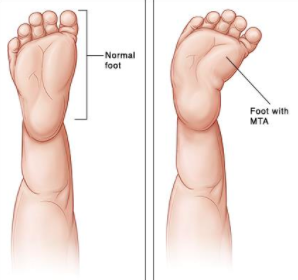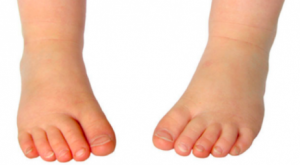Metatarsus adductus describes the shape and structure of the foot where from the midfoot to the toes, the foot turns inwards. This gives it a shape resembling a bean. Metatarsus adductus can be classified as either flexible, where you’re able to straighten the feet with your hands, or non-flexible, where you’re unable to straighten the feet with movement. This condition is usually present at birth, occurring in approximately 1 in 1000 births, and has been associated with an increased risk of developing other conditions such as hip dysplasia, which affects the stability and functioning at the hip joint.
What causes metatarsus adductus?
 While the exact cause of metatarsus adductus isn’t defined, it’s thought to be linked to the baby’s position inside the womb. It may affect one or both feet. Contributing factors are thought to include:
While the exact cause of metatarsus adductus isn’t defined, it’s thought to be linked to the baby’s position inside the womb. It may affect one or both feet. Contributing factors are thought to include:
- A family history of metatarsus adductus
- Babies positioned with the feet or buttocks coming out first at birth
- Insufficient cushioning inside the womb (through a condition called oligohydramnios)
- First pregnancy or twin pregnancies
What are the symptoms?
The primary symptom is the curved, bean-like or ‘C’ shape to the foot. There may also be a larger than normal space between the first and second toes, a bump on the outside of the foot (at the styloid process), a crease at the inner border of the foot where it turns in, and the appearance of a high arch.
How is it treated?

Metatarsus adductus should resolve within the first few months of life, although a small percentage (up to 10%) of feet don’t. This is where treatment is indicated, and may involve:
- Stretching and passive manipulation
- Orthotics/bracing/casting
- Surgery
Your podiatrist will discuss with you the best options for your child and monitor their progress throughout.
 While the exact cause of metatarsus adductus isn’t defined, it’s thought to be linked to the baby’s position inside the womb. It may affect one or both feet. Contributing factors are thought to include:
While the exact cause of metatarsus adductus isn’t defined, it’s thought to be linked to the baby’s position inside the womb. It may affect one or both feet. Contributing factors are thought to include:









